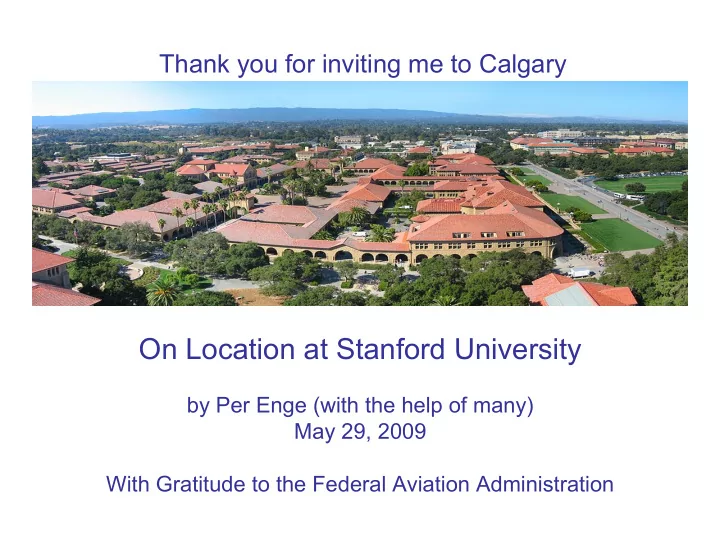

Thank you for inviting me to Calgary On Location at Stanford University by Per Enge (with the help of many) May 29, 2009 With Gratitude to the Federal Aviation Administration
from Misra and Enge, 2006 2
GPS + Galileo + Compass + GLONASS 134 Navigation Satellites? Frank van Diggelen’s new book from Artech 3
Future GNSS Signals 4
April 10, 2009 at 04:58 Pacific Time from Table Mountain, Colorado 5
Outline • Approach & Landing of Civil Aircraft • Gravimetry Using Cold Atoms • Geo-security 6
Approach & Landing Worldwide approach capability with no airport equipment. Worldwide landing capability in all weather. Free of ionospheric influence. Robust against RFI (scheduled, accidental or malevolent). 7
Safety: Faults & “Rare Normal” Events October 1993 Clock “runoffs” modulation fault 7/28/01, 5/26/03 6/11/03 & more 40 notable iono events during the last solar peak RFI events: • San Diego April 10, 2007 ephemeris • St Louis fault & 24 smaller faults • Santa Cruz over the last 5 years 8
LPV-200 Coverage on February 27, 2009 (from the FAATC live feed) 9
Near Term GBAS Installations (from Carlos Rodriguez to RTCA) over 1000 aircraft orders include GBAS avionics 10
Truncation of the Error Tail 0.14 ground dual freq. air & ground 0.12 screening GBAS screening (Cat I) (Cat I/II/III) (Cat I/II/III) 0.1 0.08 PDF 0.06 0.04 0.02 0 0 5 10 15 20 25 30 35 40 45 User Vertical Position Error (meters) 11
PRN 1 Bias on L1 12
Evolution of GNSS-Based Safety 2010 2020 2030 L1 Only • RAIM • SBAS • GBAS Dual freq. SBAS & GBAS • 24 SVs Minimum • 10 -4 from GNSS Dual freq. ARAIM • Open service • GPS: 30+ Slots • Multi-constellation • 10 -4 from GNSS GNSS Integrity Within • GPS IIIC (1 st 14) ++, or • GNSS Safety of Life • 24 SVs (GPS alone) • 10 -7 from GNSS Civil security (DoS & spoofing) 13
Dual Frequency WAAS Convert Orange to Green 14
System Definition ARAIM for 2020 GPS Compass Galileo VPL VPL VPL VPL GLONASS 15
Trade Between Constellation Strength & Multiplicity of Ground Monitors (from Juan Blanch) Civil monitoring is a trade between: • Constellation size • Robustness to SV failures • Network size (URA bounding) ARAIM 99.5% 24-1 24 27-1 27 30-1 30 coverage No Real Time 3.7% 27.5% 9.56% 87.9% 79.8% 99.6% Monitoring 8 stations 50.8% 88.3% 71.5% 96.7% 98.7% 100% 38 stations 71.2% 98.9% 90.0% 100% 99.9% 100% 16
Stanford Atom-based Inertial Sensors 5 m/hour Versus 500 m/hour (from Stanford’s Mark Kasevich) Cesium atoms are proof masses. Pulses of laser light measure relative motion between atoms and case. 17
Mobile Gravity Gradient Survey (from Mark Kasevich) RTK from Trimble 18
Gravity Gradient Survey of End Station III (from Mark Kasevich & Jeff Fixler) 19
Gravity Meter (from Helicon Publishing) 20
Airborne Gravimetry (from M. Dransfield, FUGRO) Ore deposits 21
Airborne Gravimetry • Atom gravimeter to measure gravity field at 10 -6 level • High performance GPS or laser to decouple platform motion • Overfly region of interest • Water table monitoring • Homeland security • Resource discovery & management (oil/mineral) 22
Reference System Requirements • Blimp dynamics – equivalence principal – remove blimp acceleration from gravity measurements – mm accuracy for 100 second • Terrain to estimate nominal gravity – accuracy to fraction of feature size – sub meter position • X band • Visual 23
Geo-encryption (from Stanford’s Di Qiu) Feature Geotag Receiver Database Extraction Generation Low Temporal Calibration Stage Decorrelation Grant or Match? Deny Feature Geotag Receiver Extraction Generation High Spatial Verification Stage Decorrelation Match? Feature Geotag Receiver Extraction Generation Attacker 24
Tamper-proof Hardware & Self-Authenticating Signal Feature Geotag Database Receiver Extraction Generation Loran with Calibration TESLA Grant Match? Deny Feature Geotag Receiver Extraction Generation Verification attack not possible Match? Tamper-proof Feature Geotag Receiver Extraction Generation Attacker 25
Parking Lot Attack Loran with TESLA Verification Match? Feature Geotag Receiver Extraction Generation Attacker • nearby • hopes that his received data falls within geo-fence • efficacy improves with proximity 26
Smart Parking Lot Attack Loran with TESLA Verification Match? Feature Geotag Receiver Extraction Generation delay Attacker delay + delay delay 27
Smart Parking Lot Attack 28 28
Multiplicity of Signal Characteristics Loran with Attacking Node #1 TESLA WiFi Verification Match? Link Level Security? Attacking Node #2 Any Other Feature Geotag Good Receiver Extraction Generation delay Candidates (UWB, TV, etc.) delay + delay delay 29
Conclusions • Potential utility provided by new PNT technology is stunning. • International cooperation is needed to fully realize these benefits. 30
Recommend
More recommend